Iva Hakuro Nishiki is an unusual Iva, which we used to see. Spectacular spreaded bush or a small village with a spherical crown impressive coloring shoots and leaves. Spectrum of paints, from light green and white to pink and olive color, brought this plant into the rank of the most popular in landscape design.

And considering unpretentiousness, endurance and ease of care, the perennial every year conquers an increasing number of fans.
Perfectly acclimatized to the terms of our country, Japanese Iva grows without problems and breeds, diluting the familiar green paints of the garden-park zone.
How to grow yourself in the homely area such an elegant tree or bush? What you need to know by buying and planting saplings of Willow? How to trim the IVI Hakuro nishiki? About everything - in detail in this selection of material. And the photos and video presented will help better perceive information.
Iva Hakuro Nishiki, description of the plant
- Hakuro Nishiki's willow grade belongs to the form of "IVA SOLIDIST" from the large family of IVV.
- The historical area of \u200b\u200bthe growth of Willow of the All -oletic Hakuro Nishiki is considered to be Japan, Korea and Primorye in the Far East of Russia. The moisture-loving plant of medium winter resistance can be found on raw meadows, along the banks of the rivers, in the valleys of the lakes or near other reservoirs.
- Wwa of this variety is notable, first of all, with its decorativeness: volatile, unusual shades, foliage and shape of the crown. Depending on the formation and presence of a strain, it can be elegantly hanging, reduce branches of a shrub or an empty sphere of a low church.
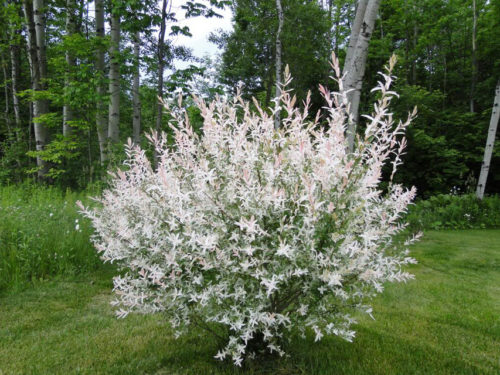
- Narrow, long (up to 10 cm) and slightly oblong leaves, there are opposite on the branches. But the color of foliage is very divergent: at the ends of the shoots, the leaves are snow-white, and in the middle of the crown - the motley. Moreover, young leaves, increasing, painted in a gentle lightweight color, and with age, tops and spots of white and purple color appear on them. The older than the sheet, the light and one-photoer of its painting, and the strokes remain rare, albeit bright. In the hot time, the leaves are a little pale and fusk.
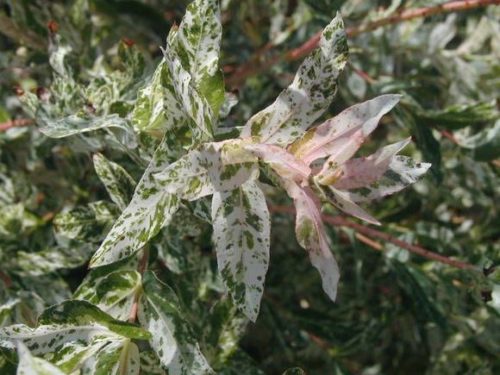
- Such an elegant decoration of Willi is often compared with the effect of Sakura flowering, and Ivu Hakuro himself is still called "Japanese".
- The plant is a low leafy shrub or a tree (grafted on the strak), reaching from 1 to 3 meters in height. The ball shape of the crown is formed quickly and often in diameter equates to the height of the plant. The more favorable climate, the greater the growth of the plant is observed. In conditions, such as the cold Moscow region, these parameters will be twice as smaller.
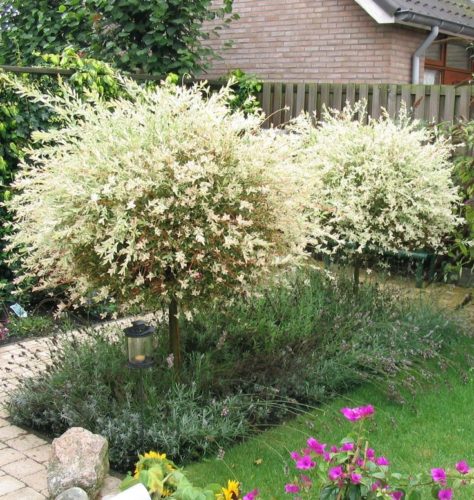
- Perennial branches are flexible and shiny, with a shade of olive or carmine. Roots - superficial.
- Iva blooms in the spring, in May, when the first leaves begin to appear. It feels a pleasant thin fragrance, resembling the smell of blooming hyacinths. The inflorescence looks in the form of husto-flowered earrings, dark purple, which are laid on last year's one-year escapes. The fruit is small, about 3 mm, the box, matures in June.
- Despite its exotic origin, the Japanese IVA grows perfectly in almost any terrain of our country. Relatively winter-hardy and endless grade, resistant to disease and pests, quickly grow up, turning into an unusually spectacular plant.
Iva Hakuro Nishiki, methods of breeding
Willow Hakuro variety varieties breeding in a vegetative way: stalling or vaccinating on a stack of willow of another variety.
It should be noted that the grafted strambl forms of Hakuro nisiki have less winter-resistance than grown worse woe from seedlings.
- The reproduction of Wawa Hakuro Nishiki with cuttings is considered the simplest and affordable way to breed culture. First, the paper cuttings are harvested. For this early spring (approximately in April) before the beginning of the growing season, the weeds are cut off. Slightly drying the cut, the cuttings are immediately planted into the soil. Some gardeners before planting cuttings, withstand them for several hours in boiled water room temperature. The cuttings quickly root and develop. Gardeners marked the rapid growth of shoots, which per year can grow for a length of about 90 cm. Under favorable conditions, the seedlings bloom after 3 years.
- We instill this decorative appearance of Willow, as a rule, on the zoom variety stack. The grafted plant is formed into one barrel and cut off the branches of the crown, creating the desired shape.
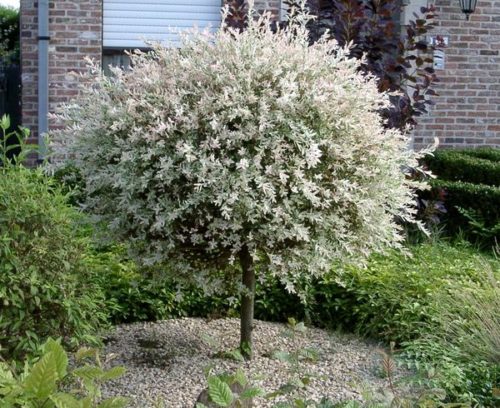
Iva Hakuro Nishiki, landing features
Given the places of growing Hakuro Nishiki in nature, its morphological and physiological features can easily determine the main preferences of Japanese Willow. It is important to initially choose a place to land this decorative willow grade to ensure the most favorable conditions for the growth and development of the plant.
In general, this long-term culture is absolutely unpretentious, but there are certain individual preferences.
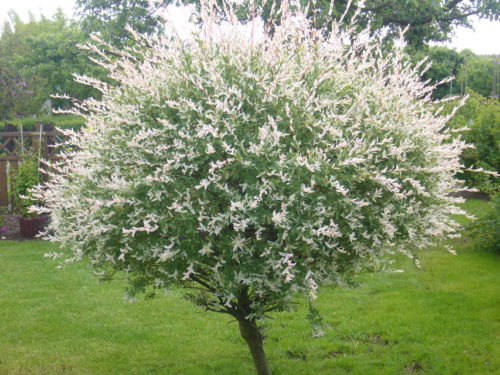
Choosing a place to land Willow Hakuro Nishiki
- Alloliste Iva Hakuro Nishiki prefers well-lit, open, with high levels of humidity, places. Sections with drafts should be avoided. For the landing of the saplings of Willow, the location is perfect near the reservoirs, in lowlands and even on partially wetlands. Willow will be able to grow in mild half, when at least half a day shines the bright sun. Strong shadow will significantly worsen decorative qualities of perennial: the leaves will flexible, fill up, and the branches stretch.
- Soil for planting does not have a decisive value, since in this regard, IVA is less than a demanding plant. With too heavy, clay soils, it is recommended to add peat and sand to the soil.
Agrotechnology landing Willow Hakuro Nishiki
- Japanese Willow Saplings plant in spring, in April-May. Gardeners are recommended to smoke the roots of the saplings willow before planting in the water. The procedure can last from 3 to 6 hours.
- The landing pit is preparing quite large, an average of 60x60 cm. I dig the pit of the right size, layer of organic fertilizers (humus, compost) lay in it. An important point, especially in the conditions of severe soil, will prepare the drainage layer. The subtype is prepared from rubble or sand, a thickness of about 20 - 30 cm. Then, exhibiting a seedling, fall asleep with a mixture of a turf with peat, sand, leaf ground. Place of landing around the plant compact legs.
- For the successful rooting of the saplings of Willow, it is regularly and abundantly watered with water for a month. Mulching of the priority circle will ensure the preservation of the necessary wet microclimate around the plant.
- The distance between the plants must be left taking into account the subsequent expandment of the willow crown. The diameter of the crown can reach 3 meters. Therefore, in group landings, the interval between the bushes is not less than 1.5-2 m.
- Given the average winter hardiness of the willow, when landing it in a cold climate, for example, in the middle lane of Russia, it is not necessary to plant stracr, but varietal seedlings, subject to ensuring their winter shelter.
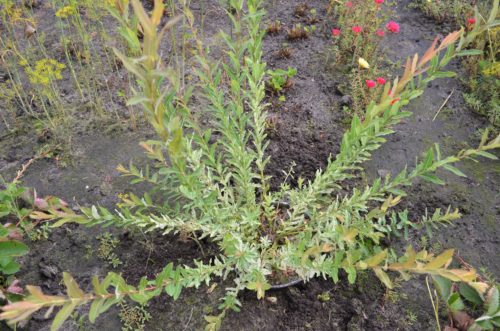
Where and how to buy Iava Hakuro Nishiki?
- Buying seedlings of solvent willow Hakuro Nishiki, should be given preference to specialized nurseries or, "won the authority", shops, including the Internet network.
- Willow seedlings are sold in the form of a core bushes or small trees, with vaccination on a strain.
- Buying saplings will be better in the region where it is planned to land. So the conditions for cultivation will be preserved as much as possible and stress reduces the plants.

- Good quality landing material must undergo a preliminary "hardening" by local climatic conditions. Therefore, it should be clarified by the seller, whether a seedling was grown in an open soil or in greenhouse conditions.
- When buying, if the seedling is not sold in a pot, attention should be paid to the presence of a largely moistened coma of the land on the root system of the plant. As a rule, such seedlings are wound by the root of a wet burlap.
- Consulting with the seller, it is necessary to clarify whether a potted seedling fertilizer prolonged action is provided. Then the culture is not necessary to feed over the next year.
- Reviews of gardeners growing grade Willow Hakuro Nishiki can be found on special thematic garden forums, clubs or sites. You can also store reviews on websites of online stores, including dedicated to the reviews of purchased products.
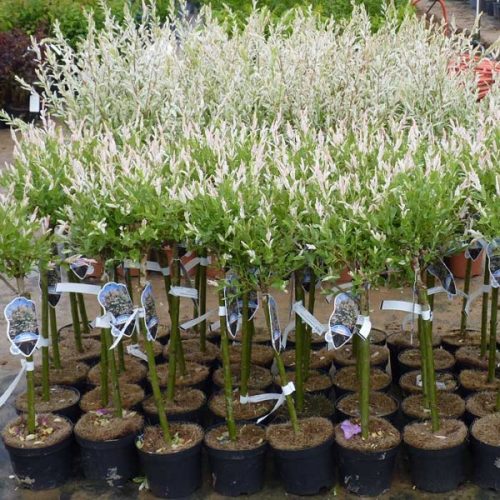
Iva Hakuro Nishiki, Care Rules
In addition to its attractive appearance, Iva Hakuro Nishiki fascinates many gardeners with simplicity and non-cultivation in care.
Watering Willow Hakuro Nishiki
As a highly aggregative plant, Iva needs a timely regular and abundant irrigation. It is especially important to follow the humidity of the soil in the arid period. The lack of moisture quickly affects the decorativeness of the shrub: the color of the leaves fade, they begin to twist and fall. Alloliste whale is much better to transfer the moisture and stagnation of moisture than drought.
After irrigation, the soil must be exploded and closed at 7-10 cm.
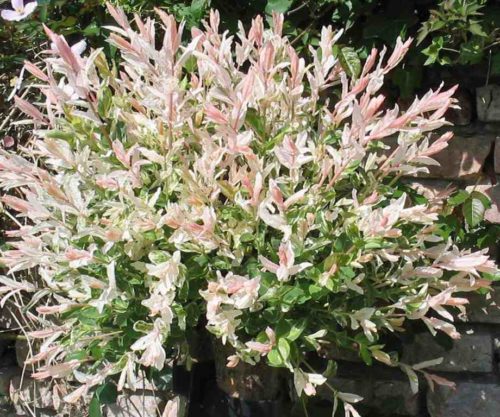
Making fertilizers for willow Hakuro Nishiki
Japanese Willow is easily leaving and grows even on scanty, not very fertile soils. But, the better the high-quality composition of the soil, the higher the decorative properties of the shrub will be.
For feeding plants, organic and complex mineral fertilizers in the region of the rolling circle are used. Fertilizers are made at the Packet Packet. The average dosage of one-time feeding is about 8-10 liters of organic and 40 g of mineral fertilizers. The plant will be enough such spring and autumn feeding.
The granular fertilizers of prolonged action also have proven well.
In the summer, it will not be superfluous to feed the leaf masses of the shrub. Such an extractive feeder is carried out with a special "adhesive" so that as many fertilizers can remain on the green mass of the shrub.
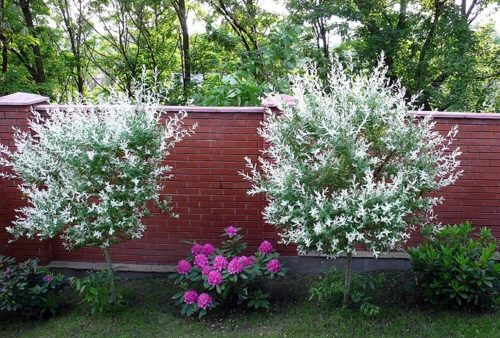
Fighting pests and diseases Willow Hakuro Nisiki
Willow Hakuro's grade is resistant to most diseases and pests. To prevent the development of fungal infections, the plant twice is treated with any system fungicide (Sorrow, Maxim, Svitch, Horus, Ordan, Radomil Gold, Quadris, etc.). Processing is carried out early in spring.
From the pests most dangerous larvae of the May Khrushche, sprinkling the roots of the plant. One larva is able to destroy up to 30 cm roots per day. As a rule, young seedlings are attacked. The preventive measure of the fight against the Khrushch will be the processing of the crown, trunk and root neck of the plant with images with the content of imidacloprid (prestige (Bayer), antichruption). The procedure should be repeated after 1.5-2 months.
Rarely Iva is attacked by green leaflerting and fruit cherry moth. For extermination of pests use special fungicidal agents.
Of the diseases of the IVA may be amazed by milder dew or necrosis of branches.
Pruning Willow Hakuro Nishiki
Pruning Willow Hakuro Nishiki is an important technological method of forming a plant crown.
The forming haircut makes the early spring, prior to the start of active deployment, after which the active growth of young shoots will be observed. New shoots, in turn, give the most beautiful and decorative attractive leaves. Do not be afraid of excessive willow trimming, as the plant is very quickly restored due to young shoots. And the spherical shape of the crown after the rustling of shoots resembles huge decorative dandelions.
To form a ball shape of the crown, in the first year cut off the shoots, leaving no more than 4-6 kidneys. This will contribute to the closure of the shape of the ball. Next, this form is constantly maintained by adding 1-2 kidney to the length of the shoots of last year. Cut branches always on the kidney, looking up.
In the summer season, the flames of the willows with a spherical shape of the crown are also subjected to forming decorative shootings of shoots to keep the desired crown shape. Extane processes on the trunk are also cut. Decorative trim can create a crown of any form.
At the end of autumn or at the beginning of the spring, the shrub is carried out: remove patients, dry, broken or unnecessary shoots.
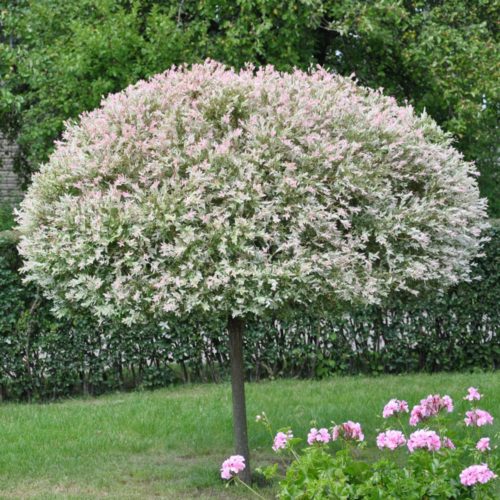
Shelter for winter Willow Hakuro Nishiki
Although the grade of Willow Hakuro Nishiki is considered moderately winter-hardy, in the conditions of a cold and honest winter, a shrub or a tree can be moderated. Especially "suffer from low temperatures Stambling Forms willows.
If subjected to freezing of shrub willows form, it does not bring significant harm to the plant. Podmerzshie and dead branches in the spring just removed.
The most vulnerable is the place grafting stam trees. Therefore, it is carefully wrapped and tied in the winter agrovoloknom, lutrasilom or other suitable materials.
To avoid freezing willow Hakura Nishiki on shtambe, plant recommended for winter fully cover nonwoven materials (except polyethylene).
Nishiki willow Hakura in landscape design
The main purpose of Nishiki willow Hakura - decorative. Therefore, many gardeners, landscape designers make extensive use of this unusual perennial plant for landscaping of gardens.
- Nishiki willow Hakura looks great both in a single planting, and planted in groups. Lonely willow, surrounded by a green lawn, highlights their individuality and independence. A group planting create truly fantastic decorations alley park ponds or coastal area.

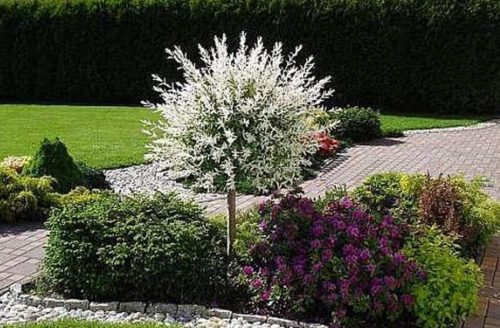
- Especially elegant willow looks at the background of green mass of other plants. Mottled pink and white and light green foliage willow successfully set off the usual green "outfit" of shrubs and trees.
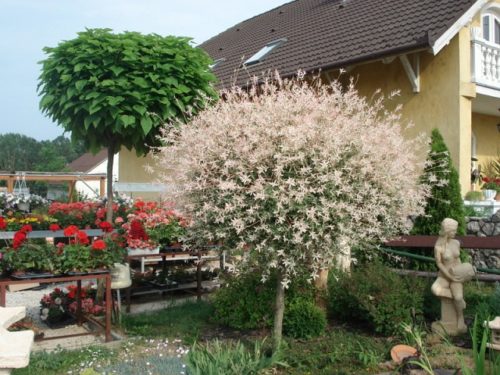

- Even in winter willow Hakura Nishiki different breeds, bright-red branches.
- Often landscape designers combine planting willow Hakura Nishiki with her cousin - a willow matsudana. Such a harmonious duet can not "pleasing to the eye" of others. Besides such landing convenient in that both types of willow similar growing conditions.

- Bushes decorative Japanese willow is often planted near the arbours, arches and benches. A low-growing forms of willow Hakura Nishiki can serve as a hedge for the garden or the park.
- In addition to its decorative value, holophylla willow perfectly strengthens the coast, the ravines and cliffs. A long, flexible shoots are used for weaving baskets, fences and other household items.

conclusions
- Yves Hakura Nishiki has high decorative qualities, perfect fit in every corner of the garden and park landscape.
- Grade fine survives and grows rapidly. Formative pruning further stimulate better growth of young shoots, and forms the decorative shape of the crown.
- Japanese willow hardly needs care, preferring moist and sunny places. Plant resistant to diseases and pests.
- Sufficient frost perennial makes it easy to grow it even in harsh environments.

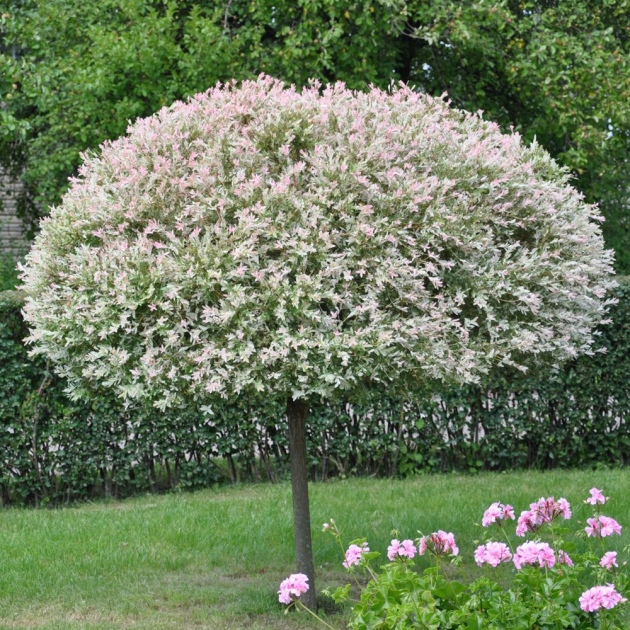
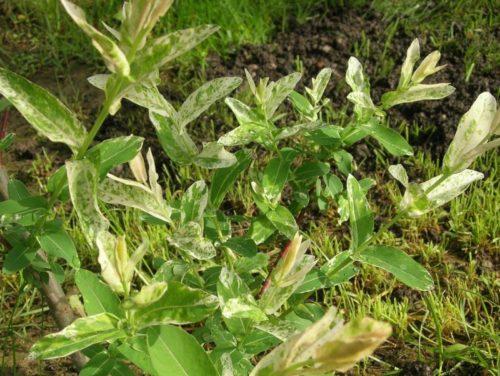
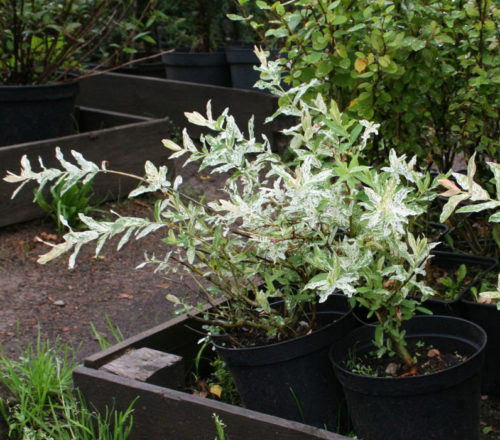
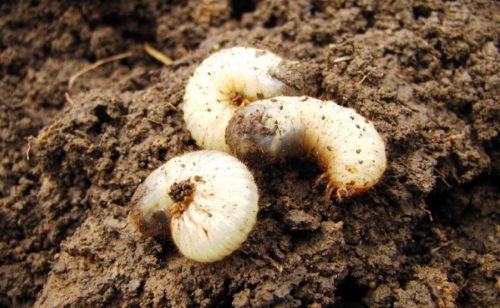
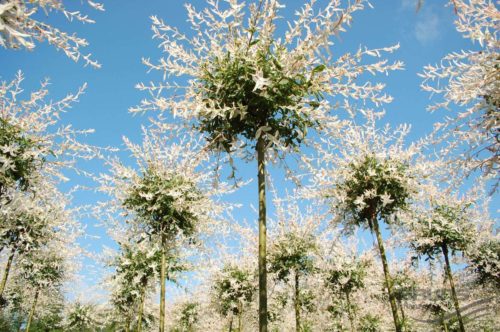
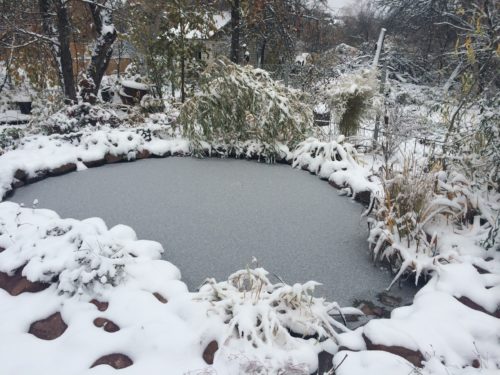

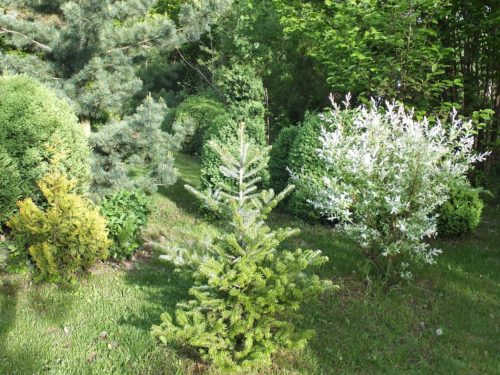
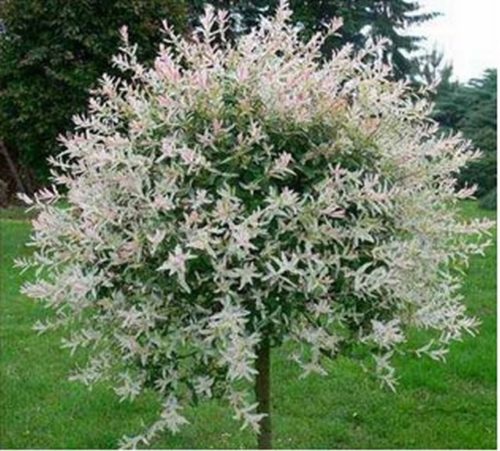













 Start a discussion ...
Start a discussion ...